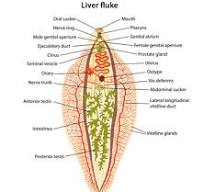Fasciola hepatica
Liver fluke
PKGhatak, MD
Fasciola hepatica is a flatworm, belongs to the Trematodes. It infects humans and other ruminant mammals.
Three other species of liver flukes, namely Chonorchis sinensis, Opisthorchis viverrini and Opisthorchis felineus have similar life cycles and modes of human infection.
In endemic areas, the liver fluke infects the hepatobiliary system and is an important risk factor for Cholangiocarcinoma (CCL). According to the WHO, people in areas of the Mekong River basin, the liver fluke infection is between 30 and 70 % of the population and the death rate from Cholangiocarcinoma is 3 %. CCL is the second most common cause of death in East Asian countries. Thailand has the highest rate of CCL, about 40 in 100,000 people, followed by China, Japan, and other East Asian countries.
The anatomy of Fasciola hepatica.
The adult worm is 3 to 8 cm in length and looks like a leaf. It has a tough outer membrane. The mouth functions as sucker and in addition has an anchoring sucker on its ventral side. It has no inner body cavity, it lives on the blood of its victim. Both male and female reproductive systems are present inside the body, and a worm usually lives for 9 years inside the bile duct of humans and mammals.
Life cycle:
Each fasciola releases 20,000 to 25,000 eggs daily in the bile. The eggs are plentiful in the stool. The eggs, when they come in contact with water, transform into embryonated eggs and seek out snails. Inside the snail, the embryos develop into elongated larvae with a long tail. This stage of the parasite is known as Miracidia. Miracidia leave snails and swim by undulating their tails to the nearby vegetation or fish, crabs and crayfish. In this second host, the larvae transform into cysts, called Metacercariae. Grazing animals or humans eat contaminated water cress, other vegetation and Crustacea and become infected.
In human victims.
The outer wall of the cysts prevents digestion in the stomach, and the cysts are propelled into the duodenum. Here the eggs are released. The larvae burrow through the intestinal wall and enter the peritoneal cavity and move to the liver. The worm grows rapidly in the liver and then enters the bile duct system and takes its final residence in the common bile duct or its branches. Within 90 days of entering the human body, the liver flukes become adult worms and begin releasing eggs in the bile.
Diseases produced by Fasciola.
Many people remain symptomatic in the early stage of infection. Others develop abdominal pain, nausea and mild malaise within 4 to 7 days when the larvae are migrating from the intestinal wall to the liver. An enlarged, tender liver and abnormal liver enzymes and eosinophilia are usually detected.
This period may last about 7 days and may last for months.
In the chronic stage. Months may pass without any symptoms. Then symptoms of biliary disease begin to occur. The common symptoms are related to gallstones, Cholangio hepatitis, hepatitis, allergic skin lesions, and the blood eosinophil count is high, which are usual symptoms. In heavy infestation of the bile duct, obstructive jaundice may occur, but usually, a secondary infection is the usual cause of jaundice.
The most serious illness from the liver fluke infection is Cholangiocarcinoma. The bile wall mucosa is damaged by the worm, endothelial metaplasia and fibrosis become recurrent and chronic. This leads to cancer development. Patients seek medical help in a late stage when surgery is not feasible or if performed, the results are not good.
Diagnosis:
Examination of stool is a simple test but diagnostic. In very early cases of suspected, asymptomatic infection, the saliva, urine and blood tests reveal the presence of Fasciola antigen. Antibody test in 3 weeks post infection becomes positive.
In advanced countries like Japan, Taiwan and others, endoscopy, ERCP, and MRI are available to detect parasites in the hepatic and biliary system.
Medical treatment.
Triclabendazole is very effective and requires only two oral doses.
People at risk:
A large population from Malaysia to Japan, China and Russia is at risk of infection of liver fluke infective cysts. Humans are accidental victims due to their lifestyles or lack of knowledge. The liver of sheep, goat and water buffalos when eaten raw or barely cooked is another source of infection besides drinking water contaminated and other food items already mentioned.
***************************************************


No comments:
Post a Comment